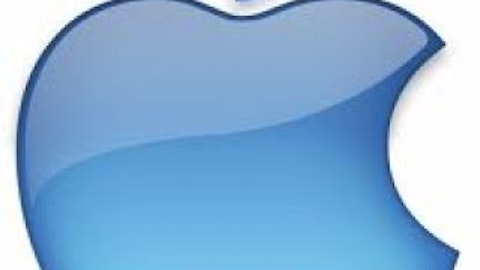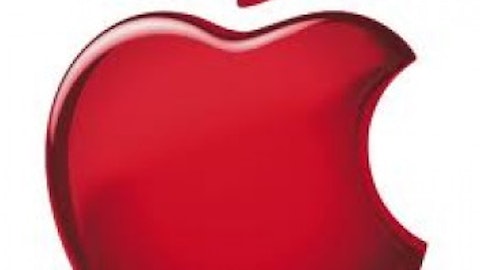Worldwide mobile data traffic will increase 13-fold over the next four years, reaching 11.2 exabytes per month (an exabyte equals one quintillion bytes) for an annual run rate of 134 exabytes by 2017, according to Cisco Systems, Inc. (NASDAQ:CSCO)’sVisual Networking Index Global Mobile Data Traffic Forecast for 2012 to 2017, published on Feb. 5, 2013. The forecast’s annual run rate of 134 exabytes of mobile data traffic is equivalent to:
1). 134 times all the Internet Protocol traffic (fixed and mobile) generated in the year 2000, or
2). 30 trillion images (e.g., via MMS or Instagram) — 10 images daily from each person on earth for one year, or
3). 3 trillion video clips (e.g., YouTube) — one video clip daily from each person on earth over one year.
Figure: Cisco Forecasts 11.2 Exabytes per Month of Mobile Data Traffic by 2017

Revenues will flow mainly from five sources — (1) mobile ads including video ads, (2) mobile retail through m-commerce, (3) mobile payments, (4) selling of hardware, like smartphones and tablets, and (5) app sales and mobile OS licensing. For creating a long-term portfolio to invest in this mobile data revolution, a revenue-wise approach can be an innovative idea.
Mobile Ads including Video Ads
Mobile searches grew four times in 2011-2012. Nearly 70% of smartphone users that watch TV and use print media or the internet do a mobile search. Mobile ad spending worldwide stood at $3.3 billion in 2011 and will be sky rocketing to $20.6 billion in 2015, driven by search ads and local ads. In the U.S. over half of U.S. mobile ad spending is local. Meanwhile Asia continues to dominate global mobile ad spend.
Google Inc (NASDAQ:GOOG) and Apple Inc. (NASDAQ:AAPL) will be the two main recipients of mobile ad spending. Google Inc (NASDAQ:GOOG)’s Android and Apple’s iOS dominate the overall mobile ad market, reports mobile ad platform MoPub. By 2017, mobile video will represent 66% of global mobile data traffic (up from 51% in 2012). Google Inc (NASDAQ:GOOG)’s YouTube will be another source of generating huge video ad revenue for the company.
Mobile Commerce
Purchasing digital goods will be the largest segment ahead of physical goods. According to an eTail survey, 87% of retailers view mobile as the biggest growth area. According to ClickIQ, 48% of retail purchases are influenced by mobile, and 29% of mobile shoppers research in-store and buy online.
Amazon.com, Inc. (NASDAQ:AMZN) will be the undisputed leader in mobile commerce. U.S. mobile commerce grew over 70% year-over-year in 2012, and accounted for roughly 10% of total e-commerce sales. As of September 2012, Amazon has 62 million unique mobile visitors and as of July 2012, Amazon’s mobile reach was 47%. This was way higher than competitors.
Mobile Payments
M-payments, i.e. paying by mobile, will be over $1 trillion by 2015. The use of near-field communications (NFC), m-banking and mobile money transfer is expected to record massive growth in the coming months and years. 1 in 8 mobile subscribers will use m-ticketing in 2015 for airline, rail and bus travel, festivals, cinemas and sports events.
Google Inc (NASDAQ:GOOG) is leading from the forefront in m-payments. Android handsets are equipped with NFC (near field communication) capabilities needed for this new form of mobile commerce. Google’s Wallet program and Apple’s Passbook payment software have no alternatives for operating such financial transactions on mobile.
PayPal is another prominent player in m-payments. PayPal accounts for about 40% of eBay Inc (NASDAQ:EBAY)’s total revenues. With PayPal still having a limited international presence, there is tremendous scope for further expansion.
Hardware Sales
Apple leads this space with record sales of its two premium devices, the iPhone and iPad. The tablet market grew 75.3% year over year in Q4 2012, up from 29.9 million units in Q4 2011, also increasing 74.3% from the previous quarter’s 30.1 million units. Apple’s iPad continued to lead the market, shipping 22.9 million units during the holiday season.
A strong iPad Mini launch, as well as the release of the fourth-generation iPad, contributed to Apple taking home 48.1% of shipment growth over the same period in the year prior. Google Inc (NASDAQ:GOOG)’s Nexus, Amazon’s Kindle Fire, and Microsoft Corporation (NASDAQ:MSFT)’s Surface will also have a significant market share in the growing tablets market.
App Sales and OS Licensing
Google and Apple make money from their mobile platforms when people buy apps from their app stores. A new report has compared both app stores to see which one raked in more revenue in 2012.
Google Play Store’s combined daily revenue has grown by 43%, according to the report. Apple’s App Store, in contrast, only grew by 21%. In terms of growth over the entire year, Apple’s App Store has seen an increase of 51% in the 20 nations analyzed in the report. The App Store generated $15 million in average daily revenue in November 2012, just after the launch of iPhone 5 and iPad Mini, while the Google Play Store only reached $3.5 million.
Microsoft’s model is different — with its Windows Phone, the company earns a license fee everytime the operating system is sold. Furthermore, due to patents, it earns money even from Android handsets.
The Bottom Line
An ideal portfolio can be built by investing in the stocks that will cover maximum revenue. I think an ideal portfolio can be like this: Google: 30%, Apple: 25%, Microsoft: 20%, Amazon: 15%, eBay: 10%
The article How to Invest in the Mobile Data Revolution originally appeared on Fool.com and is written by Anindya Batabyal.
Copyright © 1995 – 2013 The Motley Fool, LLC. All rights reserved. The Motley Fool has a disclosure policy.




